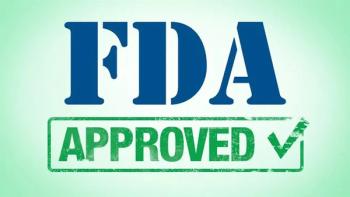
NCCN Adds Zongertinib to HER2+ Non–Small Cell Lung Cancer Guidelines
The NCCN has added zongertinib to its guidelines for the care of patients with HER2 (ERBB2)-mutated non–small cell lung cancer.
Zongertinib (Hernexeos), an oral tyrosine kinase inhibitor (TKI), has been added to the National Comprehensive Cancer Network (NCCN) guidelines for the treatment of patients with non–small cell lung cancer (NSCLC) harboring HER2 (ERBB2) mutations in the second and later lines of therapy.1,2 This update follows the FDA’s approval of zongertinib for this indication on August 8.3
Per the revised guidelines, zongertinib should be used following progression on systemic therapy for adenocarcinomas or squamous cell carcinomas.1 In patients who have disease progression at the first tumor response evaluation during frontline systemic therapy, the NCCN’s preferred recommendations are now fam-trastuzumab deruxtecan-nxki (T-DXd; Enhertu), zongertinib, with an additional recommendation of ado-trastuzumab emtansine (T-DM1; Kadcyla).
For those with stable disease or response at first tumor response evaluation on frontline systemic therapy and progression after 4 to 6 cycles, the same recommendations apply for second-line treatment.
In the third line of therapy for patients with progression on any of the recommended agents of second-line therapy, the NCCN recommends treatment with T-DXd, T-DM1, zongertinib, or subsequent systemic therapy.
The NCCN specifies that testing for HER2 (ERBB2) mutations should be part of broad molecular profiling with patients with NSCLC. At the time of the
Zongertinib’s additions to the NCCN guidelines was announced in a news release from the product’s developer, Boehringer Ingelheim.2
“Hernexeos is a meaningful advancement as the first orally administered treatment targeted for HER2-mutant non-small cell lung cancer,” noted Vicky Brown, senior vice president and head of Immunology, Oncology, and Eye Health at Boehringer Ingelheim, in the announcement. “The update to the NCCN guidelines gives oncologists further confidence in prescribing it to these patients with unmet need.”
What adverse effects are associated with zongertinib?
According to the TKI’s prescribing information, the most common adverse effects (AEs), observed in at least 20% of patients enrolled in the open-label, multicenter, multicohort Beamion LUNG-1 trial (NCT04886804), data that led to the agent’s approval, were diarrhea, hepatotoxicity, rash, fatigue, and nausea.4,5
The label warns that patients should be monitored with liver function tests, including alanine aminotransferase (ALT), aspartate aminotransferase (AST), and total bilirubin before administration of zongertinib to establish a baseline for assessing hepatotoxicity. Patients should be monitored every 2 weeks in the first 12 weeks of treatment and monthly after that window. Patients who show increased ALT/AST levels should be tested more frequently, and zongertinib should be interrupted or reduced based on the severity of the patient’s condition.
Additionally, the label includes warnings for interstitial lung disease (ILD) and pneumonitis, and patients should be monitored for such. If patients develop new or worsening dyspnea, cough, fever, or other symptoms of ILD or pneumonitis, treatment with zongertinib should be interrupted, reduced, or discontinued.
Left ventricular dysfunction and embryo-fetal toxicities are also possible with zongertinib. To assess for left ventricular dysfunction, the patient’s care team should evaluate left ventricular ejection fraction and monitor it regularly during treatment. Patients should be advised not to breastfeed during treatment.
How effective is zongertinib in HER2-mutant NSCLC?
Data reported at the time of zongertinib’s approval demonstrated that out of 71 patients who had received previous platinum-based chemotherapy and no HER2-targeted TKI or antibody-drug conjugate, the objective response rate was 44% (95% CI, 29%-61%) and the 6-month-or-longer duration of response occurred in 27% of patients.3
References
- NCCN Clinical Practice Guidelines recommend Boehringer’s Hernexeos for HER2 (ERBB2)-mutant advanced NSCLC as preferred subsequent therapy. News release. Boehringer Ingelheim. August 15, 2025. Accessed August 19, 2025. https://www.boehringer-ingelheim.com/us/media/press-releases/nccn-clinical-practice-guidelines-recommend-boehringers-therapy
- NCCN. Clinical Practice Guidelines in Oncology. Non-Small Cell Lung Cancer, version 8.2025. Accessed August 19, 2025. https://www.nccn.org/professionals/physician_gls/pdf/nscl.pdf
- FDA grants accelerated approval to zongertinib for non-squamous NSCLC with HER2 TKD activating mutations. FDA. August 8, 2025. Accessed August 19, 2025. https://www.fda.gov/drugs/resources-information-approved-drugs/fda-grants-accelerated-approval-zongertinib-non-squamous-nsclc-her2-tkd-activating-mutations
- FDA grants accelerated approval to zongertinib for non-squamous NSCLC with HER2 TKD activating mutations. FDA. August 8, 2025. Accessed August 8, 2025. https://www.fda.gov/drugs/resources-information-approved-drugs/fda-grants-accelerated-approval-zongertinib-non-squamous-nsclc-her2-tkd-activating-mutations
- Hernexeos. Prescribing information. Boehringer Ingelheim; 2025. Accessed August 19, 2025. https://www.accessdata.fda.gov/drugsatfda_docs/label/2025/219042s000lbl.pdf
Newsletter
Knowledge is power. Don’t miss the most recent breakthroughs in cancer care.




















































































